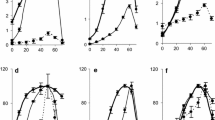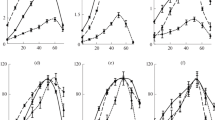Abstract
The effect of phenol (Ph, 0.25 mmol/L) on the activity and temperature dependence of casein- and hemoglobin-lytic peptidases functioning in the whole organism of chironomid larvae Chironomus sp. within the temperature range of 0−70°С at different рН values (3.0, 5.0, and 7.4) is studied. The temperature optimum of the studied peptidases of chironomid larvae corresponds to 40°С. Under the influence of phenol, the activity of casein-lytic peptidases increases more significantly at 20°С and рН 5.0 (by a factor of 3.3) and that of hemoglobin-lytic peptidases increases more significantly at рН 3.0 (by a factor of 3.5). The effect successively decreases from рН 3.0 up to рН 7.4. under both temperatures. In the presence of phenol, the shape of the curves of the temperature dependence and the Q10 values transform most significantly in the zone of high temperatures. The values of activation energy (Eact) of the process of hydrolysis of casein and hemoglobin-lytic peptidases in the zone of low and high temperatures are different. In the presence of phenol, Eact values of the process of hydrolysis of casein casein-lytic peptidases at рН 7.4 increase; at рН 5.0 they decreases in the zone of high temperatures. The values of Eact of the process of hydrolysis of hemoglobin-lytic peptidases decrease in most cases. The mechanisms of the influence of phenol on peptidase activity and digestive processes in benthivorous fish feeding on chironomid larvae are discussed.


Similar content being viewed by others
REFERENCES
Ali, S.M., Sabac, S.Z., Fayez, M., et al., The influence of agro-industrial effluents on River Nile pollution, J. Adv. Res., 2011, vol. 2, p. 850.
Anson, M., The estimation of pepsin, trypsin, papain and cathepsin with hemoglobin, J. Gen. Physiol., 1938, vol. 22, p. 79.
Boetius, A. and Felbeck, H., Digestive enzymes in marine invertebrates from hydrothermal vents and other reducing environments, Mar. Biol. (Berlin), 1995, vol. 122, no. 1, p. 105.
Le Boulay, C., Van Wormhoudt, A., and Sellos, D., Cloning and expression of cathepsin L-like proteinases in the hepatopancreas of the shrimp Penaeus vannamei during the intermolt cycle, J. Comp. Physiol. B, 1996, vol. 166, no. 5, p. 310. https://doi.org/10.1007/BF02439917
Dendinger, J.E., Digestive proteases in the midgut gland of the Atlantic blue crab, Callinectes sapidus, Comp. Biochem. Physiol. B, 1987, vol. 88, no. 2, p. 503. https://doi.org/10.1016/0305-0491(87)90334-8
Diaz-Tenorio, L.M., Garcia- Carreňo, F.L., and Ángeles Navarrete del Toro, M., Characterization and comparison of digestive proteinases of the Cortez swimming crab, Callinectes bellicosus, and the arched swimming crab, Callinectes arcuatus, Invertebr. Biol., 2006, vol. 125, no. 2, p. 125.
Dittrich, B., Temperature dependence of the activities of trypsin-like proteases in decapod crustaceans from different habitats, Naturwissenschaften, 1990, vol. 77, p. 491. https://doi.org/10.25687/1996-6733.prodanimbiol.2018.3.27-44
Dittrich, B., Comparative studies on the thermal properties of a trypsin-like protease in two hermit crabs, Helgoländer Meeresuntersuchunger: Helgoländer Meeresunters, 1992, vol. 46, p. 45.
Egorova, V.V., Iezuitova, N.N., Timofeeva, N.M., et al., Some temperature characteristics and temperature adaptations of enzymes that provide membrane digestion in poikilothermic and homeothermic animals, Zh. Evol. Biokhim. Fiziol., 1974, vol. 10, no. 3, p. 223.
Flerov, B.A., Ekologo-fiziologicheskie aspekty toksikologii presnovodnykh zhivotnykh (Ecological and Physiological Aspects of Toxicology of Freshwater Animals), St. Petersburg: Nauka, 1989.
Gad, N.S. and Saad, A.S., Effect of environmental pollutionby phenol on some physiological parameters of Oreochromis niloticus, Global Vet., 2008, vol. 2, p. 312.
Glass, H.J. and Stark, J.R., Protein digestion in the European lobster, Homarus gammarus (L.), Comp. Biochem. Physiol. B, 1994, vol. 108, no. 2, p. 225.
Gusakov, V.A., Meiobentos Rybinskogo vodokhranilishcha (Meiobenthos of the Rybinsk Reservoir), Moscow: KMK, 2007.
Ivanova, M.N., Polovkova, S.N., Kiyashko, V.I., and Bakanov, A.I., Feeding and food relationships of fishes in the Volga cascade reservoirs, in Teoreticheskie aspekty rybokhozyaistvennykh issledovanii vodokhranilishch (Theoretical Aspects of Fishery Research of Reservoirs), Leningrad: Nauka, 1978, p. 55.
Jacob, F. and Monod, J., On the regulation of gene activity, Cold Spring Harbor Symp. Quant. Biol., 1961, vol. 26, p. 193.
Kaufman, M.G., Pankratz, H.S., and Klug, M.J., Bacteria associated with the ectoperitrophic space in the midgut of the larva of the midge Xylotopus par (Diptera: Chironomidae), Appl. Environ. Microbiol., 1986, vol. 51, no. 3, p. 657.
Kim, H.R., Meyers, S.P., Pyeun, J.H., and Godber, J.S., Enzymatic properties of anionic trypsins from the hepatopancreas of crayfish, Procambarus clarkia, Comp. Biochem. Physiol. B, 1994, vol. 107, p. 197.
Kuz’mina, V.V., The effect of temperature on the digestive hydrolases of invertebrates, Zh. Evol. Biokhim. Fiziol., 1999, vol. 35, no. 1, p. 15.
Kuz’mina, V.V., Contribution of induced autolysis to digestion in secondary consumers (exemplified by hydrobionts), Dokl. Biol. Sci., 2000, vol. 373, p. 379.
Kuz’mina, V.V., Protsessy pishchevareniya u ryb. Novye fakty i gipotezy (Digestive Processes in Fish. New Facts and Hypotheses), Yaroslavl: Filigran’, 2018.
Kuz’mina, V.V., Chornaya, E.Yu., Kulivatskaya, E.A., and Sheptitskii, V.A., Effect of phenol on the temperature characteristics of peptidases in chironomid larvae - potential food items for benthophagous fishes, Probl. Biol. Produkt. Zhiv., 2017, no. 4, p. 48.
Li, X., Mengeng, X., Kong, J., et al., Molecular cloning and characterisation of a cathepsin B gene from Chinese shrimp Fenneropenaeus chinensis, Fish Shellfish Immunol., 2013, vol. 35, no. 5, p. 1604.
Louvard, D., Maroux, S., Vannier, C., and Desnuelle, P., Topological studies on the hydrolases bound to the intestinal brush membrane. 1. Solubilization by papain and triton X-100, Biochim. Biophys. Acta, 1975, vol. 375, no. 1, p. 236.
Luk’yanenko, V.I., Obshchaya ikhtiotoksikologiya (General Ichthyotoxicology), Moscow: Legkaya Pishchevaya Prom-st', 1983.
Mai, I.D., Experimental exposure of African catfish Clarias gariepinus (Burchell, 1822) to phenol: clinical evaluation, tissue alterations and residue assessment, J. Adv. Res., 2012, vol. 3, p. 177.
Matei, V.E., Influence of subtoxic phenol concentrations on conditioned reflex activity of guppies, Gidrobiol. Zh., 1970, vol. 6, no. 3, p. 100.
Michałowicz, J. and Duda, W., Phenols—sources and toxicity, Pol. J. Environ. Stud., 2007, vol. 16, no. 3, p. 347.
Monod, J., Wyman, J., and Changeux, J.-P., On the nature of allosteric transitions: a plausible model, J. Mol. Biol., 1965, vol. 12, no. 1, p. 88.
Mukhin, V.A. and Novikov, V.Yu., Isolation, purification, and characterization of the complex of proteinases from the hepatopancreas of the king crab Paralithodes camtschatica, in XX nauchno-tekhnicheskaya konferentsiya professorsko-prepodavatel’skogo sostava MGTU, Tezisy dokladov (XX Scientific and Technical Conference of Professors and Lecturers of Moscow State Technical University, Abstracts of Papers), Murmansk: Murmansk. Gos. Tekhn. Univ., 1999, p. 354.
Navarrete del Toro, M.A., García-Carreño, F.L., Díaz, L.M., et al., Aspartic proteinases in the digestive tract of marine decapod crustaceans, J. Exp. Zool. A, 2006, vol. 305, p. 645. https://doi.org/10.1002/jez.a.318
Oh, E.-S., Kim, D.-S., Kim, J.H., and Kim, H.-R., Enzymatic properties of a protease from the hepatopancreas of shrimp, Penaeus oriantalis, J. Food Biochem., 2000, vol. 24, p. 251.
Pinder, L.C.V., Biology of freshwater Chironomidae, Ann. Rev. Entomol., 1986, vol. 31, p. 1.
Qiu, L., Jians, S., Huang, J., et al., Molecular cloning and mRNA expression of cathepsin C gene in black tiger shrimp (Penaeus monodon), Comp. Biochem. Physiol. A, 2008, vol. 150, no. 3, p. 320.
Ryby Rybinskogo vodokhranilishcha: populyatsionnaya dinamika i ekologiya (Fishes of the Rybinsk Reservoir: Population Dynamics and Ecology), Yaroslavl: Filigran’, 2015.
Singh, A.K. and Chandra, R., Pollutants released from the pulp paper industry. Aquatic toxicity and their health hazards, Aquat. Toxicol., 2019, vol. 211, p. 202.
Skvortsova, E.G., Egorova, A.A., and Kuz’mina, V.V., Influence of temperature and acidity of the environment on the activity of peptidases in chironomid larvae—potential food objects of benthophagous fishes, Probl. Biol. Produkt. Zhiv., 2016, no. 4, p. 46.
Sriket, C., Benjakul, S., and Vissessangual, W., Characterisation of proteolytic enzymes from muscle and hepatopancreas of fresh water prawn (Macrobrachium rosenbergii), J. Sci. Food Agric., 2010, vol. 91, no. 1, p. 52.
Stephens, A.I., Rojo, L., Araujo-Bernal, S., et al., Cathepsin B from the white shrimp Litopenaeus vannamei: cDNA sequence analysis, tissue-specific expression and biological activity, Comp. Biochem. Physiol. B, 2012, vol. 161, no. 1, p. 32.
Tarleva, A.F., Sheptitskii, V.A., and Kuz’mina, V.V., Reaction of various systems of the fish organism to phenol and its derivatives (overview), Probl. Biol. Produkt. Zhiv., 2018, no. 4, p. 27.
Ugolev, A.M., Evolyutsiya pishchevareniya i printsipy evolyutsii funktsii (Evolution of Digestion and the Principles of Evolution of Functions), Leningrad: Nauka, 1985.
Ugolev, A.M. and Kuz’mina, V.V., Pishchevaritel’nye protsessy i adaptatsii u ryb (Digestive Processes and Adaptations in Fish), St. Petersburg: Gidrometeoizdat, 1993.
Vysotskaya, R.U. and Nemova, N.N., Lizosomy i lizosomal’nye fermenty ryb (Lysosomes and Lysosomal Enzymes in Fish), Moscow: Nauka, 2008.
Wardiatno, Y. and Krisanti, M., The vertical dynamics of larval chironomids on artificial substrates in Lake Lido (Bogor, Indonesia), Tropic. Life Sci. Res., 2013, vol. 24, no. 2, p. 13.
Van Wormhoudt, A., Sellos, D., Donval, A., et al., Chymotrypsin gene expression during the intermolt cycle in the shrimp Penaeus vannamei (Crustacea; Decapoda), Experientia, 1995, vol. 51, no. 2, p. 159. https://doi.org/10.1007/bf01929362
Zhao, W., Chen, L., Zhang, F., et al., Molecular characterization of cathepsin l cDNA and its expression during oogenesis and embryogenesis in the oriental river prawn Macrobrachium nipponese (Palaemonidae), Gen. Mol. Res., 2013, vol. 12, no. 4, p. 5215.
Zilli, F.L., Montalto, L., Paggi, A., and Merchese, C., Biometry and life cycle of Chironomus calligraphus Goeldi 1905 (Diptera, Chironomidae) in laboratory conditions, Assoc. Intersci., 2008, vol. 33, no. 10, p. 767.
ACKNOWLEDGMENTS
We are grateful to E.A. Kulivatskaya (Institute for Biology of Inland Waters, Russian Academy of Sciences) for technical assistance in the study.
Funding
This study was carried out as part of a state task, project no. АААА-А18-118012690102-9.
Author information
Authors and Affiliations
Corresponding author
Ethics declarations
Conflict of interest. The authors declare that they have no conflict of interest.
Statement on the welfare of animals. All applicable international, national, and/or institutional guidelines for the care and use of animals were followed.
Additional information
Translated by D. Pavlov
Abbreviations: Ph, phenol; Еact, the energy of activation.
Rights and permissions
About this article
Cite this article
Kuz’mina, V.V., Chornaya, E.Y. & Sheptitskiy, V.A. Effect of Phenol on the Activity and Temperature Characteristics of Peptidases in Chironomid Larvae at Different рН Values. Inland Water Biol 14, 231–238 (2021). https://doi.org/10.1134/S1995082921020097
Received:
Revised:
Accepted:
Published:
Issue Date:
DOI: https://doi.org/10.1134/S1995082921020097




